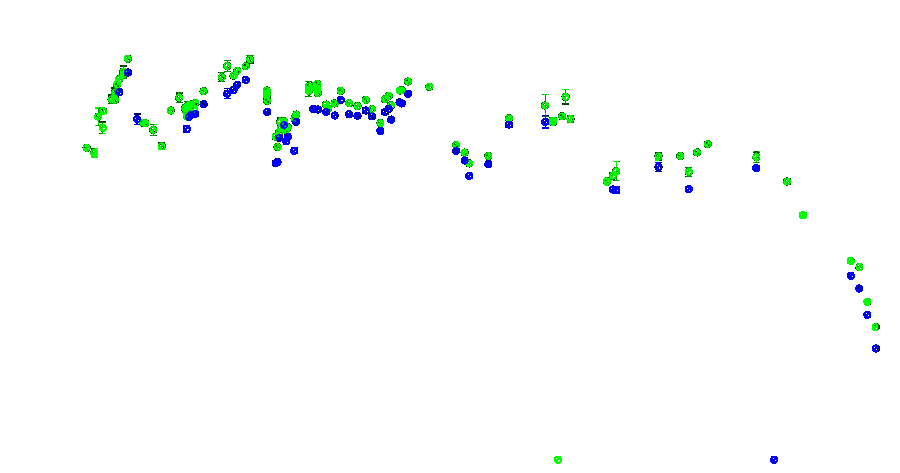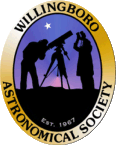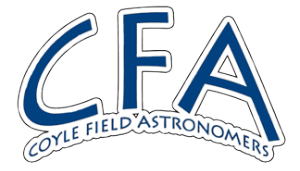Sundogs at the Mall
April 18, 2015
Late in the afternoon on April 18, 2015, while driving west to the Cherry Hill Mall in Cherry Hill, NJ, I noticed a distinct pair of colorful parhelia (sundogs) flanking the sun. After parking on the second level of the mall garage, I took the pedestrian bridge to Nordstrom's department store. Looking west from there across Haddonfield Rd, I had a fine view of the sundogs, so I snapped some pictures with my Apple iPhone 5s using the default 4.2 mm focal length. This image was captured at 6:53 pm EDT with automatic settings of 1/4115 second at f/2.2, ISO 32. Although not evident visually, a 22° halo, which intersects the sundogs, is faintly visible in the picture too. However, the sundogs, especially the one on the right, did exhibit some vertical elongation visually.
Venus and the Pleiades
April 11 & 12, 2015
On April 11, 2015, at 8:55 pm EDT, the brilliant planet Venus (magnitude -4.1) was just 2½° from the center of M45, the Pleiades star cluster in Taurus (aggregate magnitude +1.5, or 170× dimmer than Venus). This image of them was captured from Camp Ockanickon in Medford, NJ, with a Canon 6D digital SLR camera on a fixed tripod and a Canon 100 mm, f/2.8L macro lens. This single frame was exposed 3 seconds at f/4, ISO 3200. The original frame included the Hyades star cluster, about 10° away in Taurus, but the star field looked weak, so I cropped it to about 42% of the original linear dimensions to highlight the Pleiades, whose proximity to Venus was the primary impetus for this picture in the first place.
The picture below was captured on April 12, 2015, at 8:51 pm EDT, when Venus was 3° from the center of the Pleiades after moving about 70 arc minutes east with respect to the background stars since the evening before. There was some hazy cloudiness in the sky above this site in Moorestown, NJ, hence the bright corona around Venus. Taken with a Canon 6D digital SLR camera and a Canon 70 to 200 mm, f/2.8L zoom lens set to 200 mm focal length (then cropped to about 82% of the linear dimensions, so it's roughly the same scale as the previous picture). This single frame was exposed 2 seconds at f/4, ISO 3200.
Nova 2015 Sagittarii No. 2
March 22, 2015
This image of Nova Sgr 2015 No. 2 was captured on March 22, 2015, at 5:23 am EDT from Carranza Field in Wharton State Forest, NJ. Unfortunately, there were some clouds present in the sky, but there's also a cloud of Milky Way rising from the spout of the Sagittarius Teapot asterism. Taken with a Canon 6D digital SLR camera on a fixed tripod and a Canon 100 mm, f/2.8L macro lens. This single frame was exposed 6 seconds at f/4, ISO 6400. Mouseover for labels. Note: This version of the image was processed from the raw file, rather than the in-camera JPEG file originally posted, to achieve a more pleasing color balance.
Note that three stars above the spout have been labeled with magnitude values (data from SkyTools). They seem to be in roughly the same density of cloudiness and have about the same brightness as the nova. Going upwards and to the left from the tip of the spout, they are Gamma 1 Sgr, HD 165634 and HD 164975. Based on this comparison, I would estimate the nova was about magnitude 4.6 on March 22.
Here's a Sky & Telescope article about this nova and here's a PDF finder chart prepared with SkyTools. Check the links after the next picture too.
This wide-angle view of the area around Nova Sgr 2015 No. 2 was captured a short time later, at 5:32 am EDT on March 22, three minutes after the beginning of astronomical twilight. The light dome between Sagittarius and the tail of Scorpius is from Atlantic City, NJ, about thirty miles away. Taken with a Canon 6D digital SLR camera on a fixed tripod and a Canon 24 to 105 mm, f/4L zoom lens at 24 mm focal length. This single frame was exposed 6 seconds at f/4, ISO 6400. Mouseover for labels. Note: Like the previous image, this image was also processed from the raw file to achieve a more pleasing color balance.
The nova was easily visible in 16x70 binoculars since it was brighter than magnitude 5 on March 22, but not visible to unaided eyes due to the clouds. My observations on the morning of March 25 from Maple Shade, NJ, with 16x70 binoculars (and poor transparency) suggest its brightness was between magnitude 5.90 HD 169830 and magnitude 6.36 HD 171416. The average of those two stars is magnitude 6.1 for the nova, and would represent a drop of 1.5 magnitudes in the three days since March 22 at Carranza. According to this Sky & Telescope article, the nova peaked on March 21, then started to fade sharply, but leveled off as of March 26 (or perhaps even brightened a little based on these AAVSO magnitude estimates). I looked again on March 31 from Maple Shade at 5:10 am with 16x70 binoculars, and the nova has indeed brightened; I estimated magnitude 5.0 (same as 11 Sgr). April 2 at 5:25 am was the same as March 31. On April 6, with 16x70 binoculars from Maple Shade, it was magnitude 4.6 (matching it to the highlighted stars above the spout shown in the 100 mm shot above).
The AAVSO magnitude plot shown below, initially with the unusual sawtooth pattern, was generated on June 18, 2015. It shows an early sawtooth pattern, then an abrupt drop-off in brightness starting in early June.

Nova 2015 Sgr No. 2
March 18, 2015
This image of Nova Sgr 2015 No. 2 was captured on March 18, 2015, at 5:50 am EDT, 13 minutes after the start of astronomical twilight, from my front yard in light-polluted Maple Shade, NJ. Taken with a Canon 6D digital SLR camera on a fixed tripod and a Canon 100 mm, f/2.8L macro lens (then mildly cropped). This single frame was exposed 0.8 seconds at f/4, ISO 6400. Mouseover for labels. The nova was easily seen within the Teapot asterism in Sagittarius using 10x50 binoculars; the similarly-bright star to its right is magnitude 5.9 HD 169830.
Looking North at Coyle Field — Aurora?
March 17, 2015
On March 17, 2015, the Kp index was high and there was hope of seeing aurorae down here in New Jersey. It wasn't my primary reason for heading to Coyle Field this very clear night, but I did keep alert for the possibility of an auroral display, at times sensing some very faint color in the sky, but it was hardly definitive. However, it did prompt me to take some pictures, which might show otherwise invisible aurorae. This single frame was taken at 8:47 pm EDT with a Canon 6D digital SLR camera and a Canon 24-105 mm f/4L zoom lens set to 24 mm focal length. Exposed 2 seconds at f/4, ISO 12,800. It was handheld, but resting on the back of the car. Besides size reduction, no processing was applied. The Big Dipper is prominent on the right, and the pointers at the top of its bowl lead leftwards to Polaris, the tip of the handle of the Little Dipper. Note the vague magenta band above the light glow at the bottom. Many of the snapshots I took show a similar color above the glow – perhaps auroral activity, but maybe just an artifact. However, check this picture from North Jersey at the Sky & Telescope online gallery... there's a bit of similarity along the horizon. Regardless, even if this picture shows some aurora along the horizon, it's not exactly a spectacular display.
Venus, Mars and the Crescent Moon
February 20, 2015
On February 20, 2015, the two-day-old Crescent Moon joined the planets Venus and Mars after sunset. This picture of the trio was captured from Maple Shade, NJ, at 6:25 pm EST with a Canon 6D digital SLR camera at the prime focus of a William Optics 80 mm, f/6 apochromatic refractor on a fixed tripod. This single frame was exposed 1/10 sec at ISO 12,800. At the time, Venus (magnitude -3.9) and Mars (magnitude +1.3) were three-quarters of a degree apart, while Venus and the moon were just under two degrees apart (center-to-center). Venus and Mars would be at conjunction on February 21st at 3 pm EST, while the moon would be at geocentric conjunction with Venus at 7:55 pm EST on February 20th and Mars at 8:29 pm on the 20th. Mouseover for labels.
Comet C/2014 Q2 (Lovejoy)
January 15, 2015
Comet C/2014 Q2 (Lovejoy) was captured along with the constellations Orion and Taurus at 11:23 pm EST on January 15, 2015, from Coyle Field in the New Jersey Pinelands. Lovejoy is still lingering around magnitude 4, and it remains a fairly easy naked-eye object from a dark location like Coyle. Taken with a Canon EOS 6D digital SLR camera (on a fixed tripod) and a Canon 40 mm f/2.8 STM pancake lens. It's a single exposure of 10 seconds at f/4, ISO 6400. The field is about 48° wide x 33° high. Mouseover for labels. Here's a Sky & Telescope article about Lovejoy, including a nice finder chart.
The image below of Lovejoy, along with the Pleiades star cluster, was taken at 11:09 pm EST on January 15th from Coyle Field with a Canon EOS 6D digital SLR camera (on a fixed tripod) and a Canon 100 mm f/2.8L macro lens, then mildly cropped (the field is about 10° wide x 16° high). This single frame was exposed 6 seconds at f/4, ISO 12800. A faint wisp of a tail can be seen extending about 2° towards the east (to the upper left). Mouseover for labels.
Comet C/2014 Q2 (Lovejoy)
January 7, 2015
This snapshot of comet C/2014 Q2 (Lovejoy) was captured at relatively dark Atsion Field in Wharton State Forest, NJ, at 7:04 pm EST, on January 7, 2015, the day of its closest approach to earth (perihelion will be on January 30th). Lovejoy, approaching magnitude 4, was not difficult to see with unaided eyes during the approximate hour between the end of astronomical twilight and moonrise. A wisp of a tail and the greenish-bluish color were visible in 16x70 binoculars and a 12.5-inch Newtonian scope. The color (especially) and the tail (vaguely, extending roughly eastward towards the left) appear in the picture too. Taken with a Canon EOS 6D digital SLR camera (on a fixed tripod) and a Canon 100 mm f/2.8L macro lens. It's a single exposure of 6 seconds at f/4, ISO 6400. The comet, in the constellation Eridanus, was at nearly 40° altitude at the time. The field is about 20° wide x 14° high. Mouseover for labels.
P.S. -- Keid (a.k.a. 40 Eri) is an interesting triple star.
Venus and Mercury Converge
January 5, 2015
The two interior planets, Venus (above) and Mercury (below), are converging in the western twilight after sunset. They are pictured here on January 5, 2015, at 5:29 pm EST (40 minutes after sunset), when they were 1.6° apart, but on January 10th, they'll reach their minimum separation of 0.6°. This picture was taken from the Maple Shade, NJ, baseball field complex with a Canon EOS 6D digital SLR camera (on a fixed tripod) and a Canon 100 mm f/2.8L macro lens (then moderately cropped). It is a single exposure of 1/80 second at f/2.8, ISO 2500.
Click here for some older images.



